|
|
PhalaenopsisFamily: Orchidaceae.
|
|
|
 |
Genus of about 50 species of evergreen, epiphytic, monopoidal orchids occuring from sea level to lowland forest in the Hymalayas, S.E. Asia, and N. Australia. They have a short, upward-growing, stem-like rhizome, lacking pseudobulbs and producing 3-6 broadly obovate or oval, upright or semi-pendent, fleshy, mid- to dark-green leaves. Flowers, on simple or brunched racemes, are produced from the bases of the leaves. A full size Phalaenopsis can very possibly be in bloom for 6 to 8 months out of the year; producing two or more complete spikes per year. When the last flower has wilted, the spike can be cut back to about an inch above the fourth node, counting from the base. (A node is the bump on the spike.) Usually, a lateral shoot will form from one of these remaining nodes within several months. |
 |
| Growing conditions |
Watering and misting |
Propagation |
| A minimum night temperature of 62° to 65° F is optimum. Temperatures as low as 58° F will not harm the plant and would be helpful to initiate spiking, but should not be continued for more than a few weeks as the plants are more prone to fungus at these temperatures. Day temperatures should range between 75° to 85° F. Phalaenopsis prefer moderate levels of light, with NO direct sun. They do best in an east or west window that gets very early of late sun but without direct sun the rest of the day. They can also be grown in a south facing window if shaded or kept back from the window. They also do well under artificial light, or a north facing window that is open to the sky and gets very bright light. |
Never allow the plant to become bone-dry. When you water, water well, then let the plant become just moist before watering it well again. |
Cuttings or offshoots may be rooted. Some species produce plantlets on the flower spikes. |
|
Phalaenopsis parishii v. lobbi |
|
|
Very small plants with big flowers. Leaf spread is mature at 4" overall. The white flower has a hinged, chocolate lip. Hard-to-find healthy flowering size plants, but we have them. Typical phalaenopsis culture - intermediate to warm with moderate to low light. |
|
|
Phalaenopsis speciosa v. tetraspis |
|
|
Prolific bloomers that produce white flowers sometimes with gold/bronze spots or bars appearing sporadically on sepalss. Typical phalaenopsis culture, i.e., intermediate to warm with moderate to low light. Can flower almost continuously. |
|
|
Phalaenopsis violacea (bellina) |
|
|
From the Indonesean islands comes this highly fragrant species. Flowers several times throughout the year and likes it on the warm side with moderate to low light. |
|
|
Phalaenopsis violacea (bellina) v. alba |
|
|
The rare alba form (green and white) of this fabulous species is now available. Flowers several times throughout the year and likes it on the warm side with moderate to low light. |
|
|
These materials are freely provided for instructional and educational purposes. Any duplication or publication of text or images herein for commercial gain without explicit written permission of the owner or photographer constitutes breach of trust and violation of copyright.
Copyright © Galka Okhapkina 1998-2025


